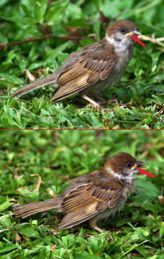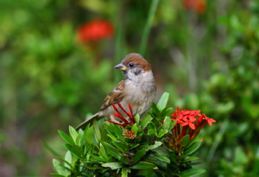I was strolling around the Singapore Botanic Gardens’ Symphony Lake one evening (14th May 2007) and enjoying the antics of the Eurasian Tree Sparrows (Passer montanus). These birds seem to suddenly become common around this area ever since visitors began feeding, first the fish, then the birds. The sparrows congregate among certain dense plantings, one of which is the ixora (Ixora sp.) patch. That set me wondering as to whether they are now beginning to nest in trees and bushes.
As everyone knows, our sparrow, although called Eurasian Tree Sparrow, traditionally nests in the eaves of houses. A few still nest in my house but as neighbours are rebuilding and apparently adopting modern roof structures, sparrows are not nesting in these modern houses. Have any birders observe sparrows nesting in trees and bushes?

That evening, I noticed a sparrow fledgling calling loudly from the ground by the pond, obviously begging to be fed by its parents. It behaved as most fledglings behave. With wings partially spread low down, it quivered its feathers as fledglings normally do. At the same time it fluffed its breast feathers (right).
And being a recent introduction to this world, it has yet to develop the instincts of being cautious oh humans. I was thus able to capture a few images in my memory card to examine them later on. Imagine my pleasant surprise when I noticed the presence of prominent yellow oral flanges (right, arrow). These develop on both sides of the mouth, extending from the corner and tapering towards the tip of the bill. They are temporary enlargement that function as targets for adults feeding the chick.
The oral flanges are prominent in the chicks of the Oriental White-eye (Zosterops palpebrosus) (1, 2), which together with the reddish gape, make a prominent food target. We now know that the sparrow has yellow oral flanges but has anyone any idea whether its gape is also red?
Eurasian Tree Sparrow is a very common bird and we tend to take it for granted. But obviously there are many aspects that are yet unknown. And if known, the information needs to be made available. As the saying goes, knowledge not shared is knowledge lost.
YC Wee
Singapore
May 2007










2 Responses